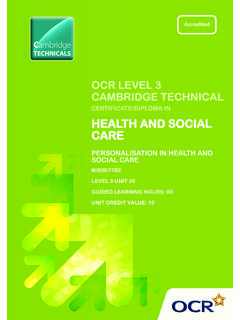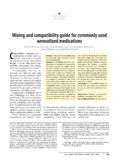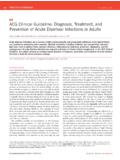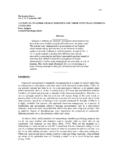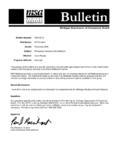Transcription of Guidelines for Case Presentations - Charlotte AHEC
1 Guidelines for case Presentations Must first choose a disease state and a patient with this particular disease state to present * all categories listed below should pertain to the disease state of choice 1. General Information at Time of Admission Patient's initials Age Race Sex Date of admission 2. Subjective & Objective Information Chief complaint Other symptoms 3. History of Present Illness (HPI) Briefly state in chronological order the presentation of symptoms leading to this diagnosis. Also give any pertinent negative symptomatology. 4. Past Medical History (in chronological order) Childhood illnesses Adult illnesses Hospitalizations 5. Patient's Family History Positive for what disease Negative for what disease Does any disease run in patient's family Conditions of spouse Conditions of offspring (or siblings for a child) 6.
2 Patient's Social History Smoking: when started, number of packs per year, when stopped Alcohol: what, how much, when Drug abuse Occupation Marital status Living conditions 7. Drug History Present Rx dose and frequency OTCs Any known allergies and explain reaction Past Rx and OTC drugs 8. Co-morbid Conditions primary vs. secondary controlled? 9. Physical Examination Vital signs, weight Any positive or pertinent negative physical findings on examination should relate to the clinical presentation . 1 Guidelines for case Presentations 10. Results of Pertinent Laboratory Tests SMA-6 CBC (H & H) Urinalysis Serum drug levels Toxicology screen Drug levels Any other special studies ordered on admission. 11. Patient's Hospital Course Summarize the patient's hospital course, bring out pertinent +/- laboratory tests, diagnostic tests, patient symptomatology, therapy, and parameters used to monitor response to therapy.
3 The hospital course should be presented in a systematic chronological sequence so as to effectively convey the impact of the patient s drug therapy on his/her recovery and/or the development of complications. This can be accomplished by running, daily diary-like commentaries, flow diagrams, charts, graphs, tables, etc. Summarized Hospital course Medications-dose, dose changes, dates of changes, missed doses, medications errors, duration of therapies, frequency of administration of prn meds, etc. Lab values with dates and times where appropriate Special procedures and miscellaneous therapeutic modalities Special test results Significant exam results and clinical observations Significant complications Problem list changes during hospital stay Assessment changes during hospital stay Changes in plan during hospital stay Critique of Drug Therapy Was drug selection appropriate?
4 Was drug dosing appropriate? Was drug therapy appropriately monitored? Did complications develop due to drug therapy? Was drug therapy effective? What additional monitoring was warranted? What therapeutic alternatives were available What would you have done differently if you were in charge of the case ? 12. Discharge Data Final diagnosis: If expired, note the pathology findings Discharge medications Plan for follow-up 2 Guidelines for case Presentations Discussion The flow of discussion at a case presentation is to be directed by the presenter. At the end of the discussion, the following question should have been answered. - Did the patient receive optimal drug therapy for his disease state and symptomatology? The presenter must decide on the best drug, dose, dosage form and dosing interval and compare the drug with other agents, to answer this question.
5 The student should be prepared to answer specific questions about the case . The following may serve as Guidelines for information you should know about your case . Disease State Be prepared to relate the patient's presentation , treatment, and hospital course to the "classic" presentation , treatment, and prognosis of the disease by considering the following: Definition Prevalence Major Symptoms Etiology Pathology Drug therapy -classic & investigational Incidence Diagnostic lab. tests Prognosis -treated & untreated Drug Therapy of Your Patient Know the pharmacokinetics, pharmacology, DDIs, and toxicology of your patient's drugs. 1. Pharmacokinetics Absorption: Comparison of sites. Agents that may effect absorption. Distribution. Protein binding. Biological half-life. Metabolism: Sites. Pathway ( glucuronide conjugation).
6 Activity of metabolites. Excretion. Normal times for onset, maximal activity, and duration. 2. Pharmacology Major actions and mechanisms. Clinical uses: accepted and investigational. Normal dosing ranges for specific clinical uses ( atropine for drying effect; for preop twilight sleep effect). 3. Drug Interactions Be aware of all possible interactions with this drug, including mechanisms if known ( protein binding replacement). Make special note of any potential drug interactions during your patient's hospital course. 4. Toxicology Symptoms of overdose. Antidotes, if any. Potential problems in treating overdose. Addiction potential (physical or psychological). Teratogenicity. 5. Counseling for oral medications Possible adverse reactions. Optimal medication regimen. Tips to improve compliance. Students should also know the: Major disease states relating to the problem; Purpose of the diagnostic tests ordered; Reason for the selected drug therapy 3 Guidelines for case Presentations Proper Referencing Format for Information Sources Downloaded from JAMA website; published: 1997;277:927-934 References should be numbered consecutively in the order in which they are first mentioned in the text.
7 Identify references in text, tables, and legends by Arabic numerals in parentheses. References cited only in tables or in legends to figures should be numbered in accordance with the sequence established by the first identification in the text of the particular table or figure. Use the style of the examples below, which are based on the formats used by the NLM in Index Medicus. The titles of journals should be abbreviated according to the style used in Index Medicus. Consult the List of Journals Indexed in Index Medicus, published annually as a separate publication by the library and as a list in the January issue of Index Medicus. The list can also be obtained through the library's Web site ( ). Avoid using abstracts as references. References to papers accepted but not yet published should be designated as "in press" or "forthcoming"; authors should obtain written permission to cite such papers as well as verification that they have been accepted for publication.
8 Information from manuscripts submitted but not accepted should be cited in the text as "unpublished observations" with written permission from the source. Avoid citing a personal communication unless it provides essential information not available from a public source, in which case the name of the person and date of communication should be cited in parentheses in the text. For scientific articles, authors should obtain written permission and confirmation of accuracy from the source of a personal communication. The references must be verified by the author against the original documents. The Uniform Requirements style (the Vancouver style) is based largely on an American National Standards Institute (ANSI) standard style adapted by the NLM for its databases. Notes have been added where Vancouver style differs from the style now used by NLM. Articles in Journals 1.
9 Standard journal article: List the first six authors followed by et al. (Note: NLM now lists up through 25 authors; if there are more than 25 authors, NLM lists the first 24, then the last author, then et al.) Vega KJ, Pina I, Krevsky B. Heart transplantation is associated with an increased risk for pancreatobiliary disease. Ann Intern Med 1996 Jun 1;124(11):980-3. As an option, if a journal carries continuous pagination throughout a volume (as many medical journals do) the month and issue number may be omitted. (Note: For consistency, this option is used throughout the examples in Uniform Requirements. NLM does not use this option.) Vega KJ, Pina I, Krevsky B. Heart transplantation is associated with an increased risk for pancreatobiliary disease. Ann Intern Med 1996;124:980-3. More than six authors: Parkin DM, Clayton D, Black RJ, Masuyer E, Friedl HP, Ivanov E, et al.
10 Childhood leukaemia in Europe after Chernobyl: 5 year follow-up. Br J Cancer 1996;73:1006-12. 2. Organization as author: The Cardiac Society of Australia and New Zealand. Clinical exercise stress testing. Safety and performance Guidelines . Med J Aust 1996;164:282-4. 3. No author given: Cancer in South Africa [editorial]. S Afr Med J 1994;84:15. 4 Guidelines for case Presentations 4. Article not in English: (Note: NLM translates the title to English, encloses the translation in square brackets, and adds an abbreviated language designator.) Ryder TE, Haukeland EA, Solhaug JH. Bilateral infrapatellar seneruptur hos tidligere frisk kvinne. Tidsskr Nor Laegeforen 1996;116:41-2. 5. Volume with supplement: Shen HM, Zhang QF. Risk assessment of nickel carcinogenicity and occupational lung cancer. Environ Health Perspect 1994;102 Suppl 1:275-82. 6. Issue with supplement: Payne DK, Sullivan MD, Massie MJ.
